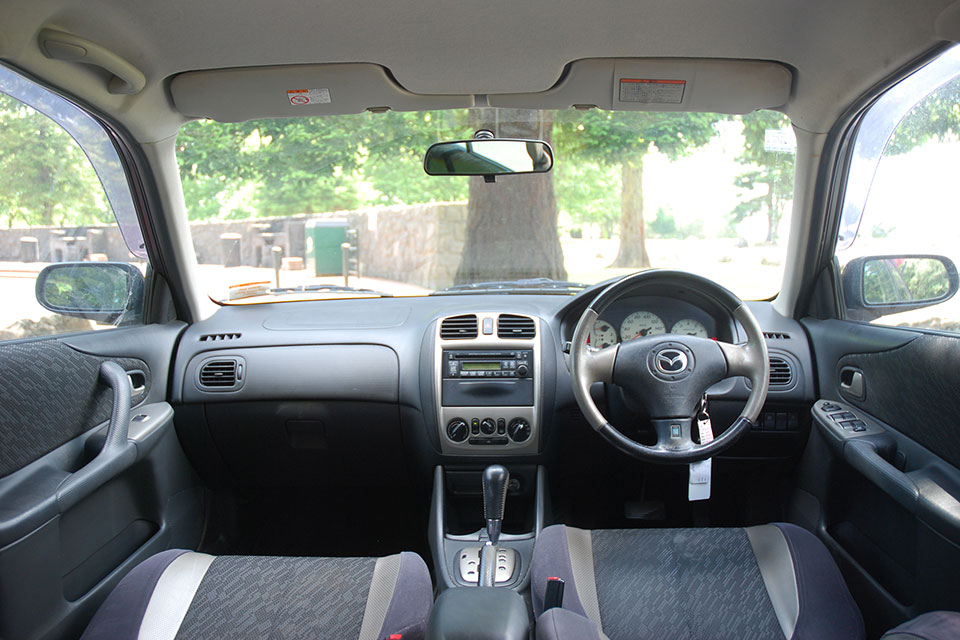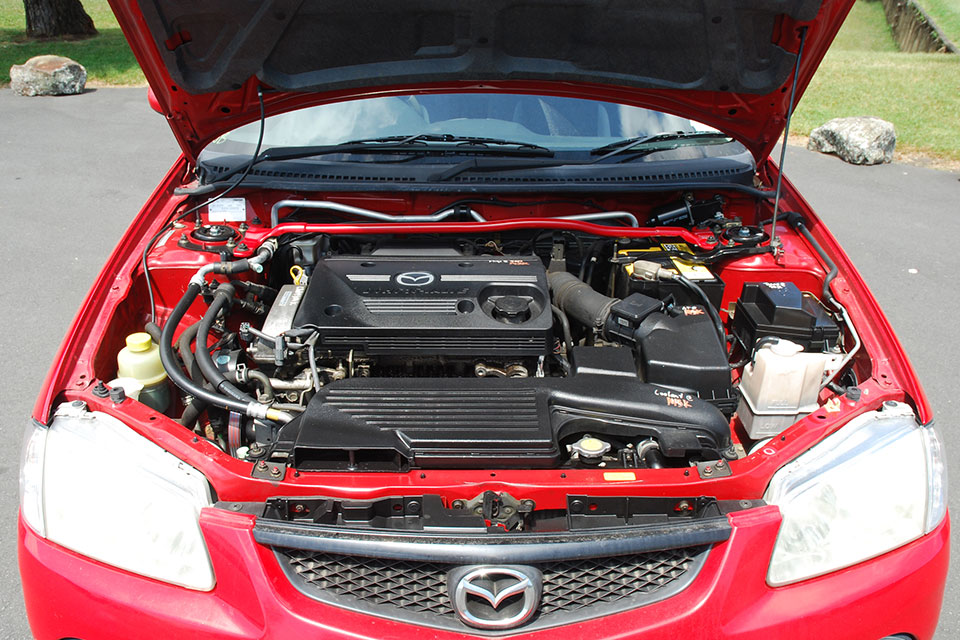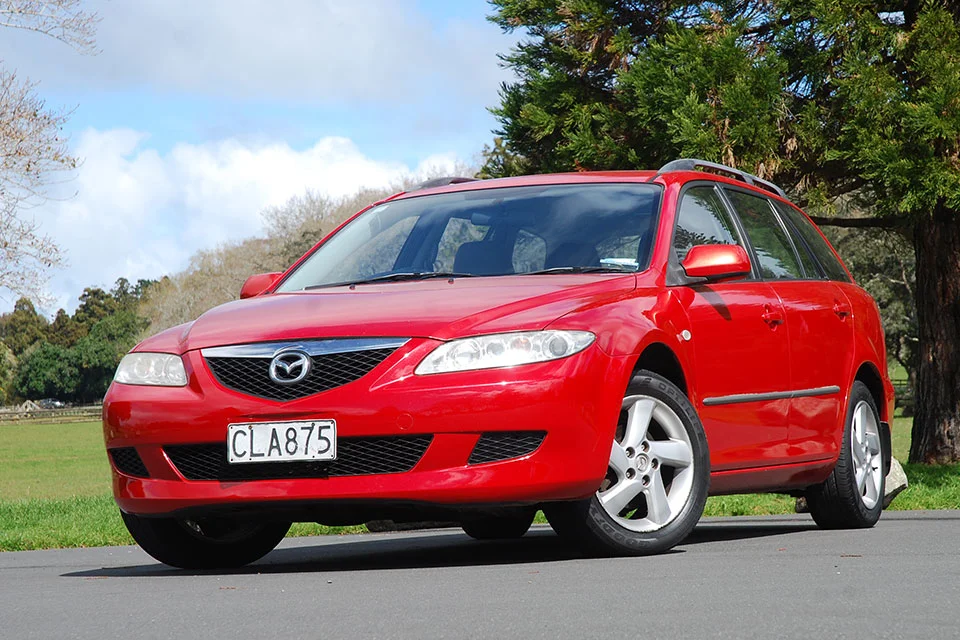Mazda Familia 1998-2003 used car review
The Mazda Familia S-Wagon offers a lot - a practical design, good driving dynamics and strong engines.

The Mazda Familia S-Wagon offers a lot - a practical design, good driving dynamics and strong engines. Finding a good one is becoming tricky.
The Mazda Familia is the Japanese version of the Mazda 323 sold in New Zealand, though it has a range of different engines and options. Our review vehicle is the “S-Wagon” or “Sport Wagon” version, Mazda's name at the time for a slightly extended hatchback. Specifically, this car is the Sport20, a performance model known originally in New Zealand as the SP20. A Familia sedan known as the Protege is also available. The Familia station wagon is a rebadged Nissan Wingroad.
Inside and out
The S-Wagon looks like most other hatchbacks, with a little more overhang at the rear. The Sport20 features a front body kit with two large, round driving lights. All models get a black plastic roof rail set low into the top of the car. This model also gets stylish 16-inch alloy wheels.
Despite the interior’s dull colour scheme, it has a lot of windows which makes the car feel bright and spacious. The steering wheel is the “Nardi” branded type with contrasting cream leather. The same colour is used to trim the centre console. The gauges are white on black for a sporty look. The basic CD player stereo will require a band expander to receive local stations. The air-conditioning is semi-automatic.
The Sport20 gets sports-style seats with contrasting fabric panels. They might look supportive but they are quite soft and do little to keep you in place if you corner hard. Rear leg and headroom is not great; kids and teenagers are likely to be more comfortable than adults.
The boot, on the other hand, is huge with three large cases and a large number of smaller items likely to fit. The rear seat splits and folds 60/40 to provide additional space. The lip of the boot is quite high which forces you to lift heavy items high to get them in.
On the road
Two engines were available in the Japanese Familia S-Wagon: a 1.5-litre four-cylinder engine and a 2-litre four-cylinder engine. Even the smaller option was one of the most powerful of its type, with variable valve timing and able to produce 92kW. The larger engine in the Sport20 produces a very healthy 125kW and 180Nm. When you drive in a relaxed way, it is a quiet and flexible engine. If you put your foot down, it is noisy and offers excellent performance. It's let down by the four-speed automatic, which is slow to shift, even using the manual option.
The way the Sport20 handles is a step ahead of other small hatches of the time. The car feels firm and stiff, partially thanks to chassis stiffening bars, including one that can be seen under the bonnet. The steering is quick and quite responsive. The brakes are large and very effective. All this can make the car a little uncomfortable on rough surfaces, so consider that before you choose this variant.
Visibility in all directions is excellent because of the big windows and a lack of chunky pillars. Quick steering also makes it very manoeuvrable. Parking sensors and cameras were not an option on the car and are not needed.
We could not find an official tow rating for the Mazda Familia Sport20. Aftermarket options are available rated at up to 1,200kg braked (a small trailer boat).
Safety
The Familia carries only a one-star Used Car Safety Rating. Safety equipment is basic - our Sport20 is fitted with driver and passenger airbags and antilock brakes. It also features a traction control system to limit some front wheel slip under acceleration.
The rear seat has no ISOFIX child seat points, with only tether points mounted on the boot floor. The centre seat has a lap-only belt, which offers less protection than a shoulder-type.
Reliability
The Mazda Familia was considered reasonably reliable for a long time. Find the right one and it could be that way for you too, although most are now aged and worn out. The engine uses a cambelt which will require regular replacement.
Look at the door opening as well. Check along the seam where the centre of the roof meets the edges. At the rear, look around the base of the door opening and even check for signs of water entry as this could indicate rust further down in the car. Examine the wheel arches for rust and muck that could hide rust. Look around the edge of the windows for rust bubbles. If you find anything at all, avoid the car or have it professionally checked.
A four-wheel drive system is a common option and these versions are prone to issues with the differential unit and automatic transmission. A simple test to determine the health of the system is to drive the car slowly round in a tight circle under moderate load and repeat in reverse, again under moderate throttle. If you feel a harsh shudder which is accompanied by a deep rumble, chances are the unit is on the way out and you should bypass the car.
Even the front-wheel drive version can experience automatic transmission issues. Let the car get warm and look for harsh shifts or slipping between gear changes. In manual versions, both fourth and fifth gear can fail over time. Also, make sure the clutch works properly
In most cases, this can be polished out using the appropriate cleaners and some elbow grease. In extreme examples, they could fail a Warrant of Fitness check and be too far gone to salvage.
The clear coat on red-painted models - including our review vehicle - can begin to break down over time.
Cost of ownership
Mazda recommends servicing the Familia every 12 months or 10,000km. Each service is likely to cost around $300. The cambelt will need to be replaced every 100,000km at a cost of up to $1,000, with the water pump and other significant items updated at the same time.
The Sport20 is more expensive to run than most other small hatchbacks. RightCar estimates that over 14,000km of driving a year you will spend $2,880 a year on fuel. At $2 a litre, the 50-litre tank will cost $100 to fill, which gives you only a short 430km range before the fuel light comes on.
A vehicle licence for the Familia is $99.02 a year, with the car in the second-cheapest ACC levy group.
Trade Me Insurance estimates insurance for a Familia valued at $4,730 will cost $39.25* per month. This is the same cost as a Toyota RunX Z of the same year.
Buyer's guide
The Familia is available on Trade Me at prices from $1,700 to $6,700. The most expensive cars are late model, low mileage 2-litre versions. Don't select a body style when you search as they are listed as both hatchbacks and station wagons.
Variants
Three main variants and a range of sub-models were available. Other than the Sport20, the other cars are near-impossible to distinguish as there was little to differentiate them and they were not badged. It may be best to buy the Familia with the specification you want.
- S - Powered by a 1.5-litre engine. Features steel wheels, driver and passenger airbags, anti-lock brakes, manual air-conditioning, cassette stereo with optional CD player and roof rails.
- R - Adds alloy wheels, premium CD player stereo, rear spoiler and fog lights.
- Sport20 - Powered by a 2-litre engine. Adds body kit, large front driving lights, sports interior trim, sports seats, leather-wrapped Nardi branded sports spring wheel, sports suspension, chassis bracing and alloy wheels.
All-wheel drive is a common option.
Timeline
- 1998 - Launched in Japan
- 2001 - Receives a cosmetic update and improved suspension
- 2001 - Sport20 model introduced
- 2003 - Replaced by Mazda3
Details
2001 Mazda Familia Sport20
$1,500 to $4,000 for models which have travelled 70,000 to 120,000km
2-litre four-cylinder, 125kW/180Nm (claimed)
Four-speed automatic, front-wheel drive
One-star Used Car Safety Rating
10,000km or 12 months
Space saver
10.3-litres per 100km (claimed)
Petrol
4265mm
1695mm
1470mm
10.4m
This review covers the Mazda Familia for model years 1998, 1999, 2000, 2001, 2002 and 2003.
Review vehicle supplied by Turners Cars.
*Our insurance estimates are based on a 35-year-old male with no accidents in the last two years, garaging the car in Mission Bay, Auckland. The car is not used for business and will cover 10,000km to 20,000km a year. We estimate with no option add-ons and $500 excess. Customise your estimate at Trade Me Insurance.
Image gallery
Also consider






